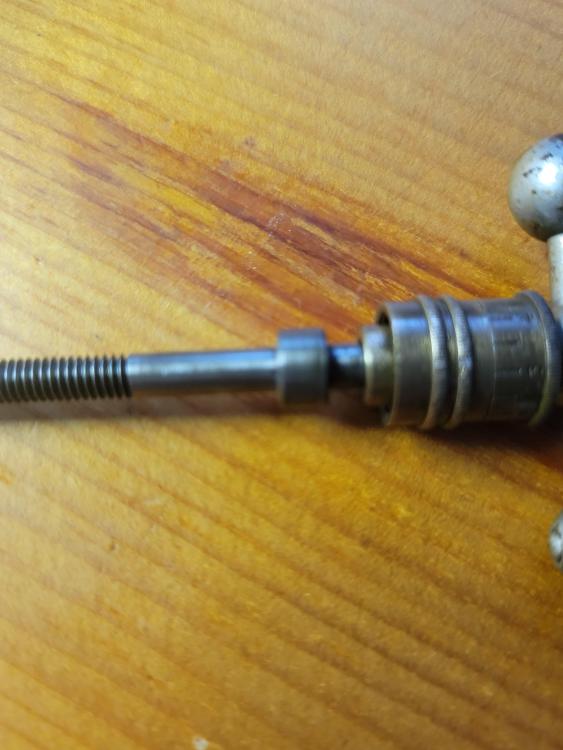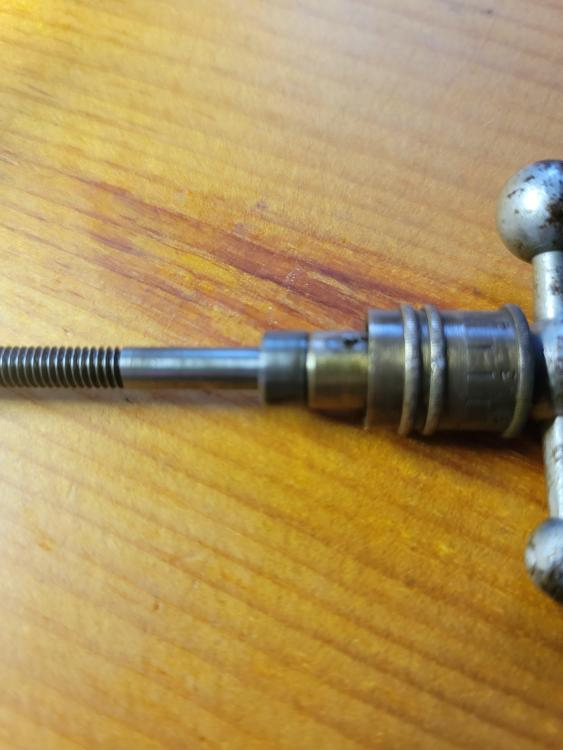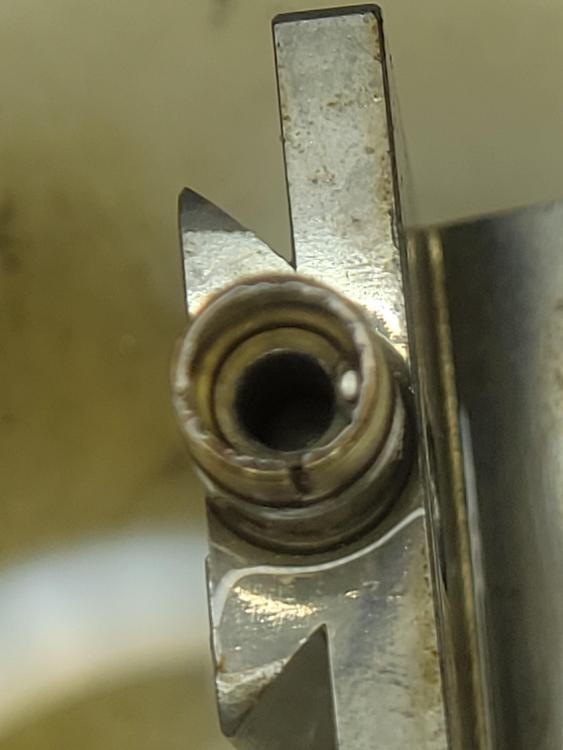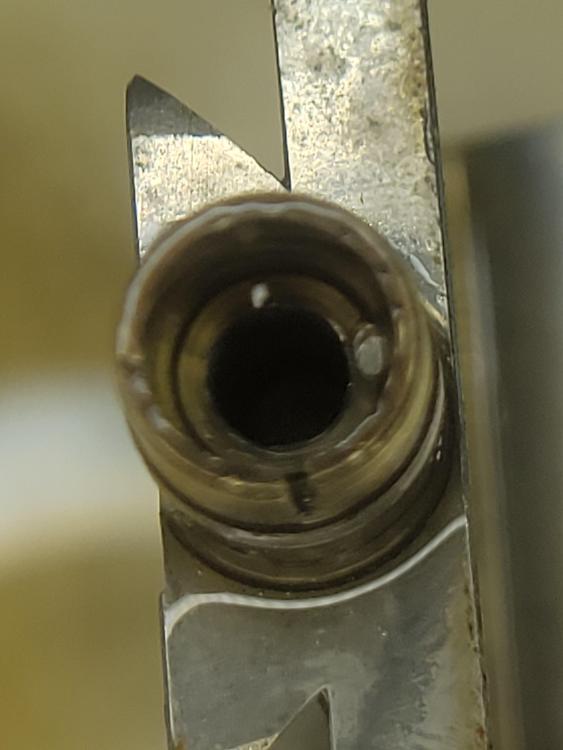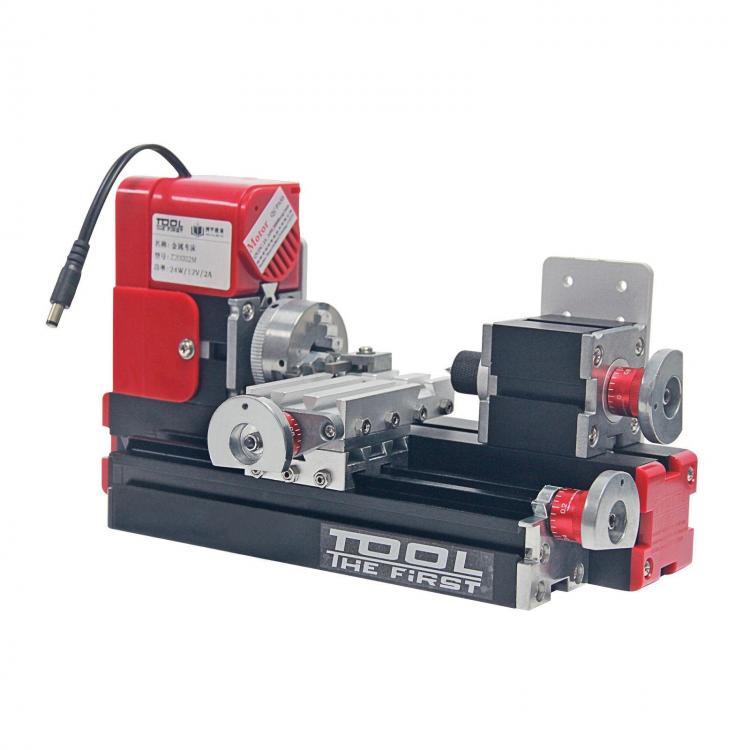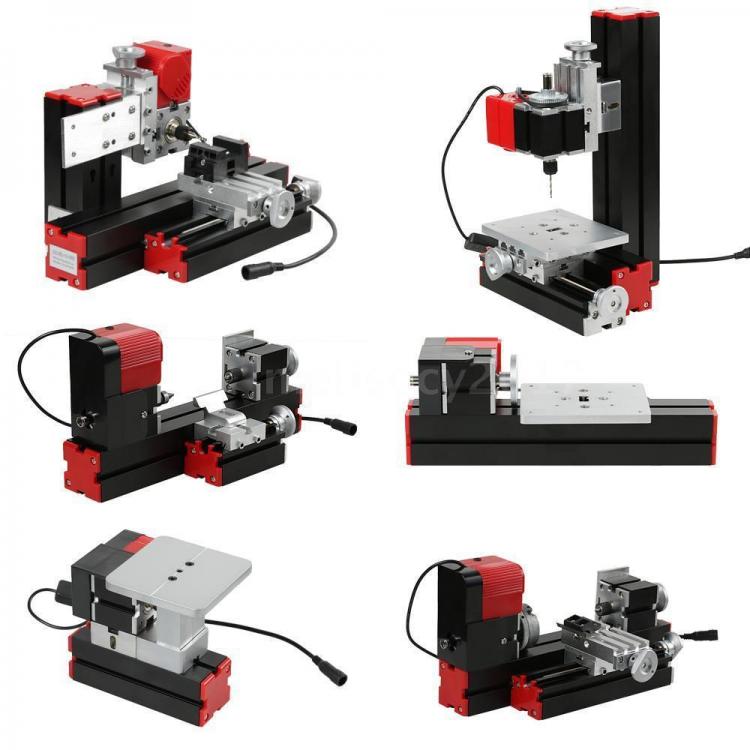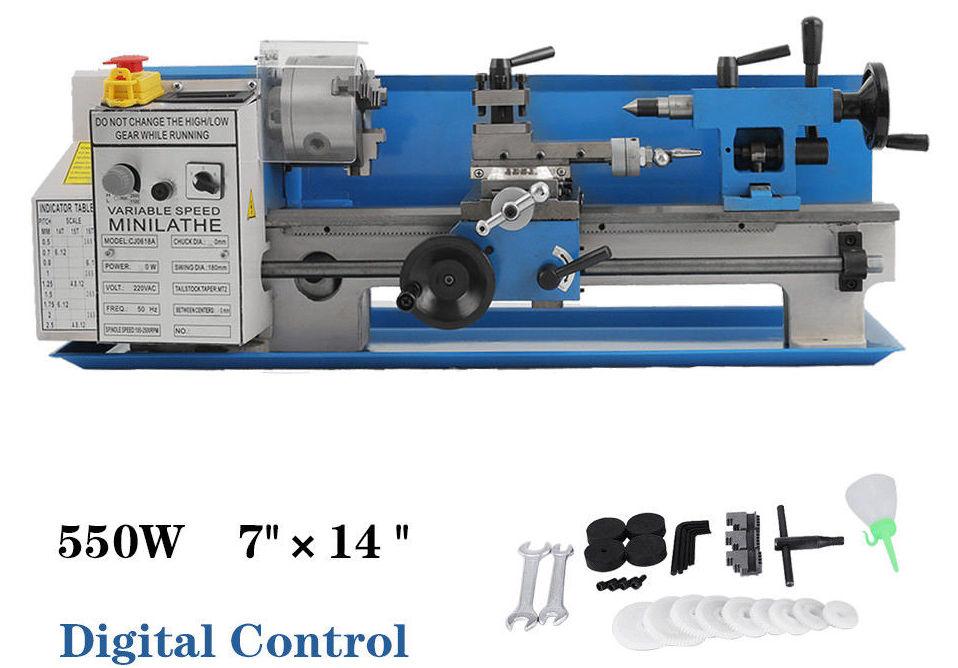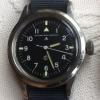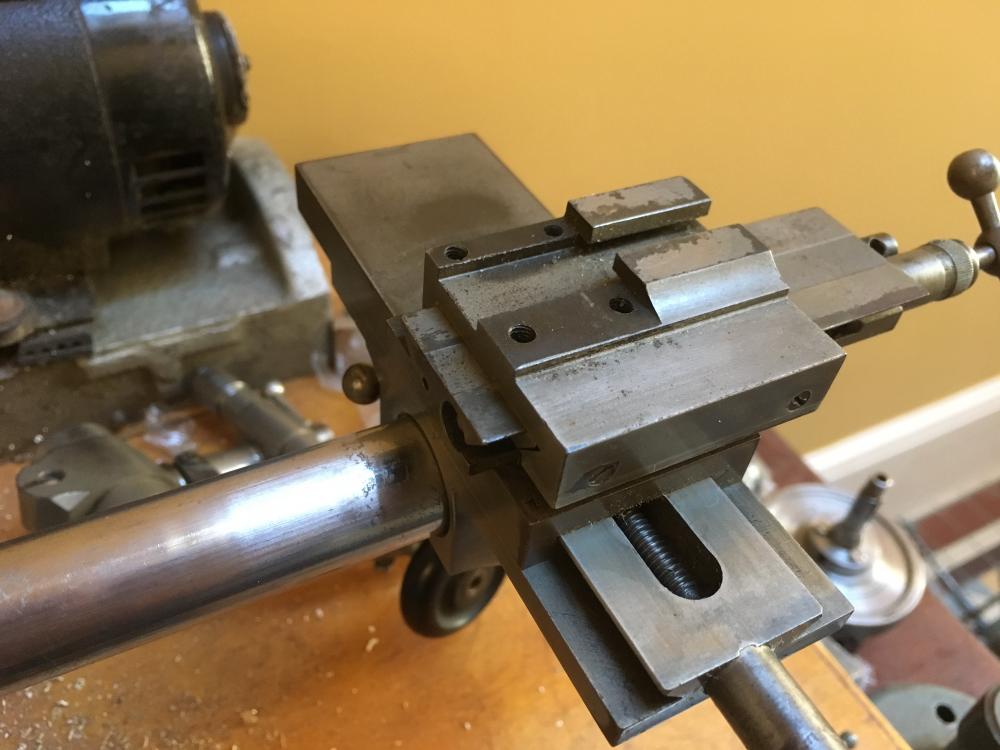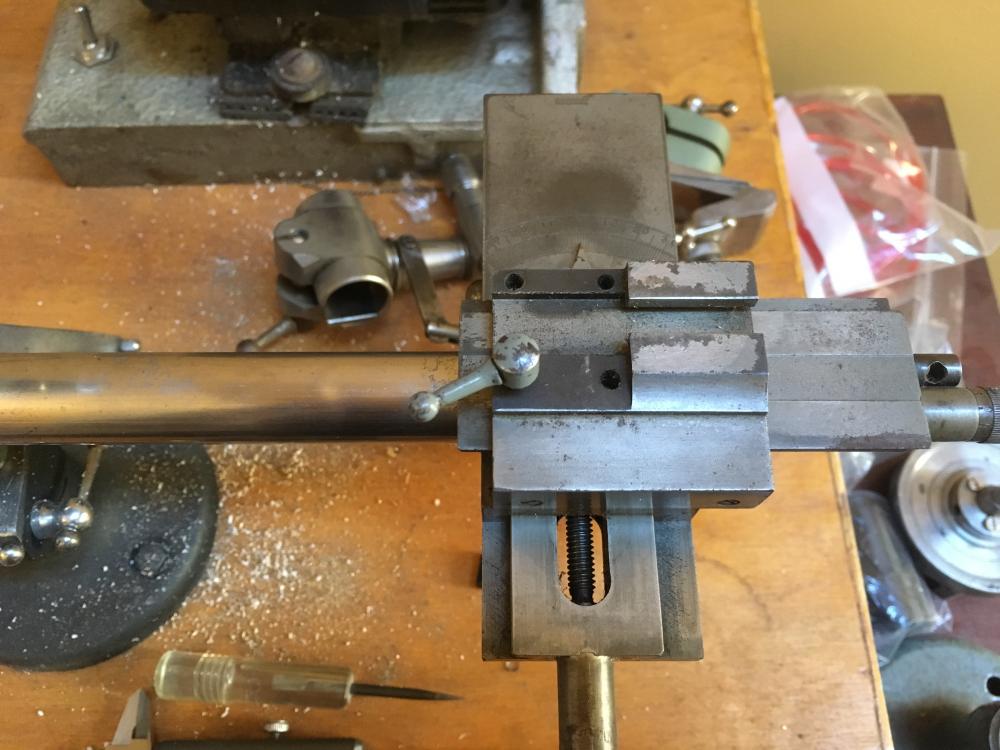Search the Community
Showing results for tags 'lathe'.
-
Purchased this compound slide for my Lorch & Schmidt 8mm lathe but upon receiving it I noticed the cross slide was backwards. No big deal, just disassemble it and reassemble it the proper way. Only as I tried removing the lead screw for the cross slide, the small steel bushing/shoulder piece came off which I have come to discover, isn't supposed to happen. Now it is stuck in the brass tube the lead screw sits in and I can't figure out how to remove it as the tube closes to the same diameter as the bushing/shoulder piece from one end (I can't just punch it out). So far I've tried penetrating oil with no success; I've tried heating up the brass tube around it hoping to break whatever potential corrosion or situation that's keeping it stuck. Maybe drilling a small hole to be able to fit a punch in and spin it around. I don't want to destroy it to take it out but will consider it if I can make or find a replacement. Any help or advice would be greatly appreciated, thank you. (Attatched are photos of what I'm talking about and what my problem is.)
- 2 replies
-
- lathe
- compound slide
-
(and 1 more)
Tagged with:
-
Good day, I have several watches with broken or missing stems, do any of the users here know if there is somewhere (other than a pot luck google search) where I could find drawings of stems? If the watch comes with a broken stem I can reverse engineer the stem and make one (when I get good enough that is), but if it is completely missing does anyone know where I can get a drawing. Failing this, does anyone know the best method to go about making a stem from scratch without an example or drawing to start from? Maybe people could share their drawings with the group as they make them to build up a little repository - even rough hand sketches etc?
-
Hi, Has anyone got one of these lathes?? if so are they any good for repairing pivots etc..I know they would not be any use for heavy work, but thought I would ask first.. Have a good weekend all.. Thanks Len
-
Apologies for re-raising this issue, but I would like to put my own spin on it (pun intended), I would like help on getting started in the world of lathes. I have reached the point where not having the ability to make parts on a lathe is starting to hamper my watch making development. However, I have never owned or used a lathe and have no practical knowledge of them, quite an admission from a 25 year Chartered Mechanical Engineer who is also a Fellow of the Institution of Mechanical Engineers.... but there you go! I can design in 3D CAD and program for a 6 axis CNC machine, but stand me in front of a manual lathe and I wouldn't have a clue. Anyway, back on topic.... I am a great believer in the 80:20 rule, so looking for a set up that will allow me to cover most of what I need (when starting out anyway) without breaking the bank on getting all the bells and whistles that would sit on the shelf for 99% of their lives - I can work on those over time. I am also looking for a setup that isn't some obscure brand or setup/size, as I want to be able to look up instructional videos etc. Not having any experience I need a volunteer(s) to "lead me by the hand"....."Scott, buy this and this and this..... there you are done!" kind of thing, also, any recommendations on YouTube/videos and other resources on using a lathe for watch making would also be great. Confession over... and thanks in advance for the help and advice.
-
Hi, I am dismantling the headstock for cleaning on my Wolf Jahn lathe, I just want to check that I'm doing it correctly. So step 1. I have loosened the screws on the Pulley. step 2. gently tap the spindle out with a wooden hammer while supporting the Pulley so it doesn't hit the headstock. Is step 2. correct? Thanks in advance Dan
-
Hi all, My task for this year is a clock that has been sitting in a tin for a long while..I need to put a new bush?? Into a contrate wheel, I have tried to make a new insert with a piece of holed brass bushing wire drilled and tapered to arbor, but split the bush reaming it out, so needs rebushing, are these bushes off the shelf?? If not, I need to invest in a small lathe, I have looked at the those on ebay for about £450 are they capable/suitable or do I need a proper watchmakers lathe as they do look a tad big for what I want to do, a Boley? Well that Is out of the question....As usual any help greatly appreciated..
-
Well this isn't really a walkthrough because I'm learning on the fly but I felt it was worthy of sharing as the story will probably return some good advice. A bit over a year ago I picked up a Breitling Navitimer movement complete with crown, dial and slide rule. There were a few parts missing and a couple of broken pieces but I corrected those issues in short order and stored the movement away for that day when a case would come available. A few months later just such a case came up on eBay and I picked it up for a fair price even though the bezel was missing. The case has some issues- for example the threads for one of the chronograph pushers were stripped out (note the pusher held in with glue below) and it looks like the bezel was removed with a forklift. I widened the stripped out pusher hole and pushed in a stainless steel sleeve which will be tapped to accept the proper pusher (2.5mm tap, pitch 0.20mm). This work was completed some time ago then the project stalled out as replacement bezels are about as common as unicorns. Frustrated by this I decided to roll up my sleeves and turn a replacement. The correct bezel is approximately 3.25mm tall with a 41.0mm outside diameter, so I started with a 304 stainless steel ring which is 6.00mm tall and has an outside diameter of 41.0mm. I've not turned stainless steel on the lathe before and was hoping to start with a softer grade (say 400) but was limited by what would fit in my three jawed chuck. Now for anyone who is thinking, "you can't turn stainless like that on an 8mm lathe" you are of course correct (for the most part) but try I did and with a carbide graver I was able to make pretty quick work of the piece- chips were flying nicely but OH BOY DOES IT GET HOT! About twenty seconds of turning was all I could do before cooling the graver; this is of course why you always see stainless steel milled or cut under a stream of coolant. Since my workspace is limited and I don't want to make a big mess I moved on to Plan B (which was actually Plan A because I never figured I'd successfully turn a replacement stainless steel bezel on the lathe). Plan B was using brass, which meant I could put the carbide gravers away as they aggressively dig into brass like it's chocolate. This time I started with a thick brass washer and my usual HSS graver. Pretty soon I was knee deep in shavings (which are useful for bluing screws). I turned the washer to a ring with an inside diameter of 37.5mm. A recess was then cut 1.0mm deep to accept the crystal on one side and the inner bezel ring on the other. The inner bezel ring (on which the bezel is mounted) is about 1.8mm tall so the recess needed to be about 2.00 mm tall to accommodate the inner bezel ring and the slide rule. Getting the dimensions just right was achieved by using a black sharpie and a scribe (needle in a pin vice) to mark out the cuts then constantly checking and rechecking the fit. Once a proper fit to the case and crystal were achieved I proceeded to cut the exterior of the bezel. The cuts were done by eye then checked and rechecked for proper fit and finish. The outside diameter of the bezel where it meets the case tapers to 40.0mm and if I cut too much there's no way to add the material back. The current status is promising- below are the pictures as it stands today without notches. I'll be cutting the notches this weekend using a fine round escapement file. To ensure the notches are evenly spaced the plan is to remove a stainless steel bezel from another Navitimer I own and glue it to this one. The notches in the stainless bezel with then serve as pilot holes to guide my file. Once completed the plan is to have the bezel plated and the case professionally refinished (laser welded, etc.). Even though it's not correct for this watch, I'm thinking I'll probably have the bezel yellow gold plated as it will be easier to sell when and if a proper stainless steel bezel ever comes to replace it. A few things I've learned along the way that might be helpful- Don't get discouraged- I was 95% done two days ago when the bezel slipped off the chuck at speed and deformed- I had to start the whole thing over again. I did get to test my notch making skills on the bent piece though and that's worth something. A three jaw chuck isn't really the right tool for this job. There is a five or six jawed chuck for holding bezels, if you can find one, I'll bet it's a lot grippier. Turning large brass rounds on a lathe is great for your confidence. You'll think you're a master until it comes time for clean-up when you realize you really do need a proper machine shop (separate from your service workbench).
-
I would like to understand if the threading for the accesories made for the Sincere lathe (faceplates, chucks, collets, etc) are compatible with the Cowells 90CW lathe. My use case is the fabrication of bridges for existing movements that can be engraved / finished by myself. I would like to start with the cheaper Sincere lathe and accessories, and then upgrade the lathe to the 90CW while keeping all the Sincere accessories. Outside of the actual operation of the lathe, I am quite a novice in the intricacies of accessory threading. I would also like a recommendation (book, online resource, etc) on how to adequaltely assess the compatability between the accessories of two distinct lathes.
-
Hi, Has anyone seen a tool post mount like the one on my Wolf Jahn slide rest? It has a conventional slot on one half, but the other half has a plain face with four screw holes. Could this be for attaching a vertical slide? I’m wondering if I should machine a square with a conventional slot and screw this down so that I can attach my tool holder closer to to the work (and thus reduce tool chatter). Also, does anyone know what screw sizes thy used on German lathes? The screw sizes are 3.2mm and 3.5mm and the thread pitch is 0.725mm, so neither Metric nor BA or Thury Thanks.
-
I have read many oblique references to the watchmaker's lathe, in fact I have heard of a book devoted to that subject, but I have not read it. I am a hobbyist struggling to learn enough to clean and oil watches that I collect and wear. Although that is all that I do now, I hope to improve my skills to the point that I can repair watches. Here is my situation. I have come across a watchmaker's lathe that is for sale at a price that I can afford. Despite seeing references to a lathe, I have never heard specifics about what tasks are accomplished with this tool. Are they useful for the hobbyist? What are they used for? Are they useful in the hands of a beginner? Any other thoughts about the usefulness of a lathe would be appreciated. Thank you in advance. Bill H. Georgia, USA
-
This is an excellent video on how to setup the correct grind angles on High Speed Steel. https://www.youtube.com/watch?v=2R0l6I1yrrk

